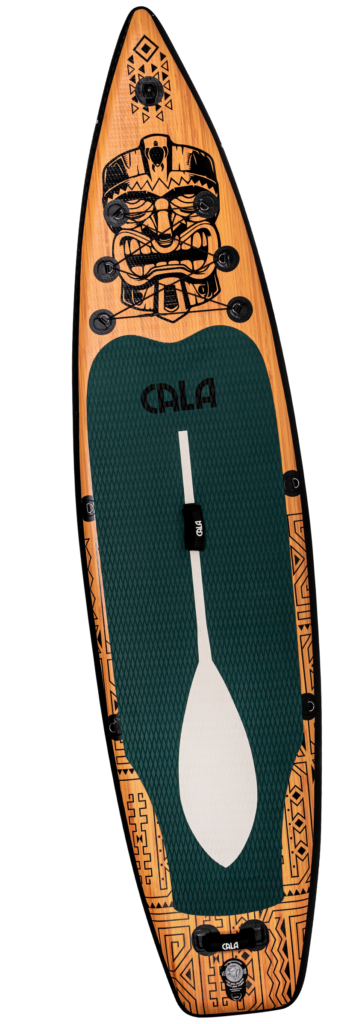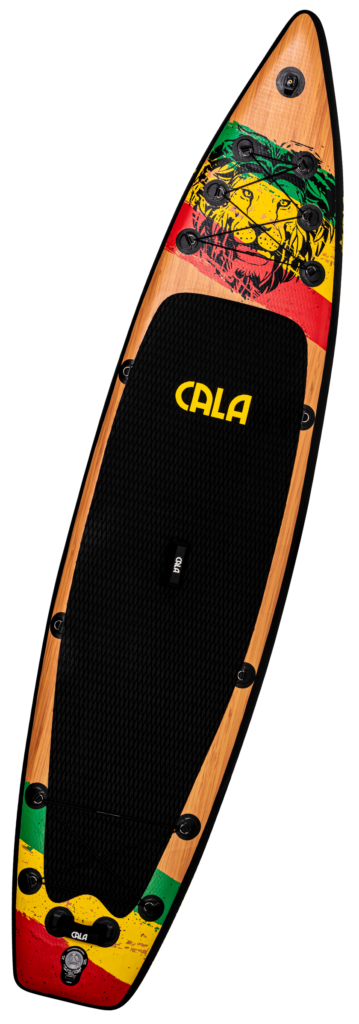Should a SUP Board be Stored Indoors or Outdoors?
The question of whether SUPs should be stored indoors or outdoors cannot be answered universally. In general, water sports equipment can be stored both indoors and outdoors. However, the material is crucial. Depending on it, the board may only be stored indoors or can withstand being outdoors for extended periods, even in winter.
Solid stand-up paddle boards (hard boards) can be easily stored outdoors. Even the basement or garage are suitable storage locations. However, storing inflatable SUPs is a bit more challenging. If you own an iSUP, it's advisable to store it indoors in the house or garage. Additionally, several considerations must be made when storing an iSUP.
Tip 1: Never Store the iSUP in Direct Sunlight
Especially during the summer months, more and more people are drawn to rivers and lakes with their inflated stand-up paddle boards. It's common to see inflated SUPs lying in direct sunlight after being pumped up. However, you should avoid this practice after inflation. Once your inflatable SUP is pumped up, store it in the shade – unless you're actively paddling on the lake. But why is this important?
Why Shouldn't an SUP be Stored in the Sun during Summer?
The heat from the sun causes the air inside the SUP to expand. While paddling provides sufficient cooling from the surrounding water, this is not the case when the board is left in direct sunlight. Just 60 minutes in the summer sun can increase the pressure inside the board significantly, leading to seam tears or even bursting in extreme cases. Therefore, it's best not to inflate an iSUP to the maximum allowable pressure during summer. The more air in the board, the less room it has to expand in the sun. Inflate your SUP only as much as necessary.
Another issue with storing an inflatable SUP in the sun is the adhesive pads. The heat can cause the glue to come loose at various points or even cause the pads to fall off.
Tip 2: Avoid Storing the SUP in the Car for Extended Periods!
Just as an SUP should not be left in direct sunlight, it should also not be stored in a hot car during summer. Temperatures inside a car can reach up to 60°C (140°F). This can damage the SUP – whether inflated or folded in a bag. While a large van might tempt you to store the inflated SUP inside during summer months to avoid the hassle of pumping it up, this convenience can be harmful to the SUP. It's best to store it slightly inflated in a cool, dry place.
Tip 3: Can the SUP be Stored Inflated?
In general, it's beneficial to leave an SUP inflated as it's the gentlest option for the material. But how much pressure should be maintained? 5 to 7 PSI (pounds per square inch) is sufficient when storing an inflated SUP. It's important that the board maintains its shape and gives slightly to pressure. Avoid placing heavy objects on it, as this could cause the stand-up paddle board to deform.
How Long Can You Leave an SUP Inflated?
If you want to keep your SUP fully inflated, you should use it regularly. While you may notice a slight pressure drop over time, it's not a significant issue. However, it's not recommended to store the SUP fully inflated for an extended period without use. Over time, this could cause fatigue in the material. Instead, release the pressure to less than 15 PSI. Optimal pressure is 5 to 7 PSI, significantly extending the board's lifespan. By the way, have you ever wondered about the warranty on an SUP? First, it's essential to know that a warranty is not legally required. It's a voluntary service provided by manufacturers.
Therefore, warranty periods vary from manufacturer to manufacturer of stand-up paddle boards. It could range from 1 to 5 years.
Tip 4: Storing the SUP Wet and Packed Is Not a Good Idea
If the SUP is packed wet after a tour, it must be unpacked at home immediately. The transport bag is strictly for transport purposes only and not suitable for storing a wet SUP. Storing a wet SUP in the bag for several days, especially in a hot car, can cause damage. This can lead to mold growth or even adhesive failures at the seams. Plan to allow the slightly inflated SUP to dry in the shade after your next tour. If you must pack the wet SUP, roll it at home to dry.
Tip 5: How to Transport an SUP?
The question of proper storage of an SUP is also related to how it's transported. If you have a hard board, you can transport it on a roof rack on your car or strap it to a bicycle trailer.
Transporting an inflatable SUP on a roof rack is also possible, but ensure the board is not overinflated to avoid deformation from the straps. However, it should not be inflated to its maximum capacity. Alternatively, you can transport the SUP rolled up in its transport bag or carry it inflated under your arm.
While hard boards can withstand being stored on a roof rack throughout the season, even in the sun in a parking lot, the same does not apply to inflatable boards. The pressure from the straps can deform them. It's better to store the board on a wall mount or lying on the floor.
What to Consider When Storing an Inflatable SUP in Summer? A Brief Summary
If you want to store your inflatable SUP during summer between tours, you must pay attention to several things as mentioned.
- Most importantly: Do not store the inflated inflatable SUP in the sun. This could cause irreparable damage to the material.
- The SUP board should not be stored while wet. Besides the risk of mold formation, unsightly mildew stains can develop. In the worst case, the glue of the seams could also come loose.
- Do not use the board as a storage surface. This could cause the material to deform.
- Always release some air for storage of the iSUP. 5 to 7 PSI is sufficient.
- Protect the board from direct sunlight and heat. Therefore, do not leave it in a hot car, especially if you won't be using it for a while. There are better places to store the SUP.
- The storage location should generally be cool and dry.
How to Store an Inflatable SUP in Summer? Here Are Your Options!
By now, you know that the SUP prefers a dry and cool environment. Therefore, indoor storage is always the best solution, especially if you plan to use the iSUP again in the next season.
However, not everyone has a large apartment, garage, or spacious basement to properly store a SUP. Fortunately, there are now several solutions available that allow you to store your SUP correctly even in small city apartments.
These are essentially three options:
- Leaning the board against the wall.
- Securing the board with a strap system.
- Fixing the board to the wall or ceiling with brackets.
Storing the SUP Board Leaned Against a Wall
This method is particularly useful in old buildings with high ceilings. Even short all-round SUP boards unrolled and inflated can reach a considerable length of 3.05 meters. Touring and race SUP boards are even longer. It's beneficial if you live in an old building. To store the inflated inflatable SUP leaned against the wall, follow these steps:
- Place the board with the stern down in front of the wall.
- Lean it against the wall with the nose facing the wall. Under no circumstances should the nose serve as a support surface.
- Ideally, secure the board somehow to prevent it from falling over.
- The board will have a particularly stable position if you set up the stern with some distance from the wall.
The advantage of this storage method is that the fins do not need to be removed.
Securing the Board with a Strap System
However, if you're not lucky enough to live in an old building, the comparatively low ceiling height at your home will hinder the storage method described above.
Fortunately, there is another simple way to store an SUP in a space-saving manner. Special strap systems are available for mounting on walls or ceilings. It's important that the straps used are padded to prevent damage to the board.
Fix the board with brackets on the wall or ceiling.
The last method is the most popular way to store your SUP. Not only is mounting the brackets completely uncomplicated, but they are also usually designed for boards of different sizes. Furthermore, they don't cost too much. However, the fin should be removed from the board for this type of storage.
Some wall mounts for stand-up paddling boards are long frames, similar to a shelf but without the board, that are screwed to the wall along their entire length. Other systems consist of individual hooks that are anchored into the wall for storing the SUP.
Important: When buying a wall mount, make sure to pay attention to its intended use. Because there are not only stand-up paddling boards but also numerous other water sports - including surfing. And the problem is: Inflated SUP boards, as well as hard boards, are much thicker than surfboards. Therefore, most surfboard racks are too narrow for SUPs and thus unsuitable.
The right SUP maintenance before storing for winter
To properly store your SUP for winter, you need to make it "winterproof." In other words, remove the traces of the summer season.
How do I care for my SUP?
To prevent damage to the material of the SUP board during winter storage, you must first thoroughly clean it. Rinse the board thoroughly with clean water. Use a soft brush to remove coarse dirt. Never use corrosive or acidic chemicals. Stubborn stains can be removed with a special cleaning and care product for SUP boards or with household cleaner and extra mild PVC cleaner. After cleaning, treat the SUP with a care product specifically designed for your board or with a care product for inflatable boats. Then, inspect the board for any possible damage, paying particular attention to the valve. However, caring for the stand-up paddle board is also an essential task during the summer months.
Regularly Maintain Your SUP
If you use your SUP board frequently, it should be maintained regularly. Cleaning every two to three months is advisable.
- Never clean the SUP board in direct sunlight.
- Inflate the board.
- Use a non-aggressive cleaning agent or a special board cleaner along with a soft cloth for cleaning.
- For stubborn discoloration on the deck pad, use a soft brush. Occasionally, a dirt eraser can be effective here.
- Check the board for damage.
- Dry the board with a soft cloth. Then, let it dry completely in the shade outdoors.
- Apply a special care product to seal the SUP, using a soft cloth to apply it to the surface. However, avoid applying it to the deck pad.
- Afterward, you can store it again. The ideal temperature for storing the SUP is 20°C (68°F).
What to Consider After Using the SUP in Saltwater!
Both hard boards and inflatable SUPs can be used in the sea. In general, saltwater does not harm the material. However, after a ride, always rinse the board immediately with clean tap water. This is particularly recommended for all metal elements to prevent rust.
However, the material can be affected over time by salt crystals that are not rinsed off. This is especially true if you roll up the board directly after your sea outing and slide it into the transport bag. If there's no opportunity to clean the board immediately, do it at home or at your vacation accommodation. It's also advisable to rinse the transport backpack to remove any salt residues.
Can a SUP be Used in Below-Freezing Temperatures?
As long as a body of water is not frozen over or has small ice pieces floating on it, you can use the SUP even in below-freezing temperatures. The material is more resistant than you are in this regard. However, while you don't need to take precautions with the board, you should consider several things for yourself. Safety should always be your top priority when using a SUP in below-freezing temperatures. Therefore, never go on a tour alone. If you do, have a cellphone with you and inform your family or friends about your planned route. Avoid making changes to your tour in this case.
Additionally, wear a drysuit instead of a wetsuit when using the SUP in below-freezing temperatures. Drysuits fit snugly against the body and prevent water entry. They are also breathable and transport sweat from your skin outward. For better thermal insulation, wear appropriate base layers and insulated neoprene shoes. Gloves, a scarf, and a hat are also essential.
The Proper Storage of Hard Boards
While the text primarily focuses on the proper storage of iSUPs, it's also important to consider the storage of hard boards. Although such boards are much more robust than inflatable variants, there are still some things to keep in mind when storing them.
- Proper Care
Like inflatable SUPs, hard SUPs also require proper care. Rinse the board with clear tap water, removing all traces of salt, sand, and algae completely. For heavy dirt, you can mix a mild soapy solution and use it to clean the board with a soft cloth or brush. Avoid using abrasive cleaners. There should be no soap residue left on the board.
- Proper Drying
Thoroughly dry the SUP board. Despite the seemingly resilient material, hard SUPs should not be left in direct sunlight for storage as it can make the material soft and porous.
- Storage
For hard boards like Decathlon SUPs, it's best not to store them directly on the ground. Since they are designed for water use, prolonged storage on the ground can cause deformation. Instead, use an appropriate rack or hanging system. There are systems with wall hooks or straps available. Ensure even weight distribution during storage to prevent improper board deformation. Also, protect the fin with an extra cover; typically, a foam fin cover is included with the boards.
Post-Season Check: Spring Check Before First Use After Winter Storage of SUPs
Before embarking on the first tour of the new season, the board needs to be checked, especially for inflatable variants, which requires some effort:
- Inflate the SUP to maximum pressure and check for air leaks.
- Inspect all seams while the SUP is inflated.
- Ensure the deck pad, D-rings, and paddle holders, if present, are secure.
- Check the fin and fin box by inserting the fin if it was removed for storage.
- If insertion is difficult, you may need to replace the screw or thread.
- Lastly, check the valve. If air escapes, tighten the valve with the appropriate valve key. This also helps determine if the valve is in good condition or not before the spring check, especially if the slightly inflated SUP loses air during the winter months.
How Long Does an SUP Hold Air?
Generally, the air in an SUP lasts indefinitely. However, like with an air mattress, there may be a slight loss of pressure over time, usually negligible. If you notice a significant pressure drop, the valve may be the culprit. It may have loosened and needs tightening or the valve pin may be jammed or dirty. In such cases, remove and clean the valve while the SUP is deflated. Then reinsert the valve and tighten everything with the valve key. If air still escapes, the valve may need replacement.
Proper Storage of an SUP
Properly storing an SUP is important not just in winter but also during the paddling season. Avoid storing the SUP in direct sunlight during outings. Also, refrain from storing it between trips. The hot temperatures can damage the boards' material, whether inflatable or hard boards. If storing an inflated SUP, reduce the maximum pressure to 5 to 7 PSI. The board can then be leaned upright against a wall or mounted on suitable holders. The same applies to hard variants; do not use them as surfaces for other items as it can cause permanent deformation. Boards prefer dry and cool rooms, ideally at a room temperature of 20°C. Thoroughly clean your SUP before storing it to ensure a smooth start to the next season's tour in spring.


